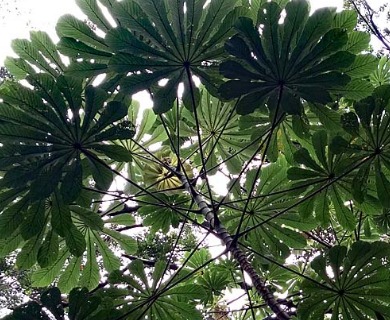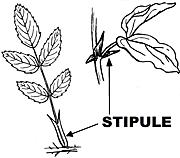Trumpet Tree
Cecropia obtusifolia
Nettle family (Urticaceae)
Post-Cook introduction
The trumpet-tree, introduced as watershed cover, is easily recognized by the very open of few stout hollow branches and few very large long-stalked umbrella-like leaves deeply divided into 9–15 oblong whitish beneath. A medium-sized tree to 50 ft (15 ) high, with branches arising high and curving upward. The trunk to 8 inches (20 ) in diameter has a few prop roots at base. Bark light gray, smooth and warty, with prominent rings. Inner bark whitish, fibrous, almost tasteless, its sap turning black on exposure. Branches are few, very stout, hairy, greenish gray, smooth with prominent rings and dots, and hollow. End buds are large, short-pointed, about 4 inches (10 ) long, covered by a large dark red hairy (), which falls early, leaving a ring scar.

©2016 Riley Pollom
Flower clusters (groups of spikes) paired at leaf bases, develop inside a large pointed pinkish hairy bud and bear very numerous tiny flowers, male and female on different trees (). The male flower cluster is composed of 12–15 yellow ropelike branches 3 1⁄4–5 1⁄2 inches (8–14 ) long and more than 1⁄8 inch (3 ) in diameter, hanging from a stalk of 1 1⁄2–4 inches (4–10 ). The tiny yellow male flowers 1⁄32 inch (1 ) long have a tubular and 2 Female flower cluster consists of 3–6 greenish or whitish ropelike branches 6–14 inches (15–36 ) long and 3⁄16 inch (5 ) in diameter, hanging from a stalk to 6 inches (15 ) long. The numerous tiny female flowers in a mass of whitish hairs have tubular and with one-celled one ovule, short and enlarged hairy
The fruiting branches (multiple ) consist of 3–6 long greenish or gray ropelike branches more than 1⁄4 inch (6 ) thick and slightly fleshy, hairy when dry, covered with brown dots. These are the individual one-seeded (), less than 1⁄16 inch (1.5 ) long, dark brown.
The wood is yellowish and soft, with large pith, hollow in branches. According to tests elsewhere, it is suitable for pulpwood. The fibrous bark has been made into ropes. The wood of a closely related species, Cecropia peltata L., from Puerto Rico was tested at the Forest Products Laboratory and found to be suitable for certain low value uses as lumber or veneer. The wood is similar to that of black cottonwood in density and strength, but has a very high tangential shrinkage, which results in severe drying degradation (Bendtson 1964).
Sparingly introduced in Hawaii. It was aerially seeded in the Panaewa Forest Reserve near Hilo in 1928 and has become naturalized there and in the lower Waiakea Forest Reserve. It is also common near Kilauea, Kauai, where it has naturalized, and at the end of Manoa Road on Oahu. A total of only 752 trees are recorded as having been planted by the Division of Forestry, mostly in 1927 and 1928. It is a pioneer and weed tree of very rapid growth in clearings, other open areas, and secondary forests. Special areas: Waimea Arboretum, Waiakea
Champion
Height 70 ft (21.3 c.b.h. 9 ft (2.7 ), spread 72 ft (21.9 ). Paradise Park, Honolulu, Oahu (1968).
Range
Native from Mexico and Belize through Central America to Panama and northern South America
Other common names
trumpet; guarumo (Spanish)
Botanical
Cecropia mexicana Hemsi.
In Hawaii, this species apparently was introduced under the name of a related West Indian trumpet-tree, Cecropia peltata L., which was also planted. The latter, which is common in Puerto Rico, differs in leaves less deeply divided into short rounded and the 2–5 short stout fruiting branches 2 1⁄2–4 inches (6–10 ) long and 3⁄8–1⁄2 inch (10–13 ) in diameter.
The English common name refers to a use of the hollow branches and leaf-stalks for trumpets or other musical instruments.
Hollow branches of this and related species in their native homes are inhabited by biting ants that bore holes to the interior. Early naturalists supposed that the ants repaid the tree by driving away other insects. However, the related trees in Puerto Rico have no ant dwellers and are abundant. On the Hawaiian trees, few small harmless ants, also introduced, were noted.







